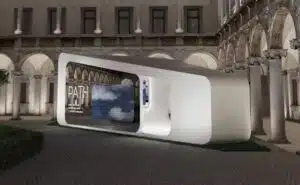La history of design European inevitably passes through that French. In the volume 'Design - history and counter-history'. by Andrea Branzi published by Jointsused in the master's degree from the Italian Design Institutethere is a valuable excursus on the various eras and styles, including the French.
With two historical matrices behind it, the Greek and the Neo-Gothic, French design at the end of the 20th century was still strongly influenced by these two currents, having never seen a true Renaissance. Another characterising component was the great tradition of the French aerospace industry, from the TGV to the Concorde (a true flying cathedral), which gave the country an identity of modernity.
The late-industrial design from beyond the Alps takes up the disruptive vision introduced by the radical designcolourful, romantic, exaggerated, producing a new awareness of the methods and objectives of production in general. An unprecedented creative register was born, hand in hand with a renewed access to an appreciation of the value of objects.
Philippe Starck, the enfant terrible of French design.
Born in 1949, Parisian, intelligent and cultured self-taught, free from conformism, and with a controlled professionalism, he is the heir to the French aerospace tradition.
A child of art - his father was an accomplished aircraft designer - Starck sets his designs on aerodynamic sections, super-lightweight structures and pointed arches, in a constant search for a new quality of life by experimenting with technologies that allow him new breaths and new expressive possibilities.
The Iconic Alessi Juicer by Philippe Starck from Patryk Kizny on Vimeo.
The tension of abandoning aesthetic work gives way to a social-political urgency and the use of performance materials.
At the same time, the patterns of a traditional vision of the object are broken, subverted, to give vent to an ironic, almost instinctive creativity, in which imagination and intelligence, naivety and strategy are skilfully mixed. The juicer Juicy Salif by Alessidesigned by Starck in 1988, became an icon of the 1990s, an instrument of transgression from conventional stereotypes.
Today Philippe Starck is considered the number one of European designerscapable of encompassing a multitude of attitudes and skills, from object design to packaging and brand communication and dissemination.
Philippe Starck_Brand Trailer from a rheum on Vimeo.
Strongly representing the design of France are also Ronan and Erwan Bouroullecheirs to a pre-Enlightenment tradition that echoes Molière. Their projects, such as the floating house for artists, the Cloud bookcase and the Butterfly container, designed for Cappellini, mirror a more provincial and less fanatical France, more modest and gentle, opening up environments to an unexpected aesthetic dimension, in which the object acquires, almost unexpectedly, a hermeneutic capacity.
Among their best-known works is 'Algae', the plastic furniture element exhibited at the New York Museum of Modern Art. It is a new generation design object, which allows the user a free interpretation, according to his needs and sensibility.




